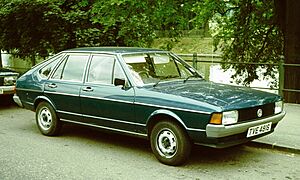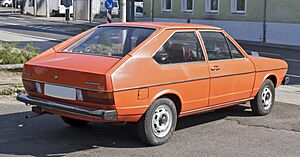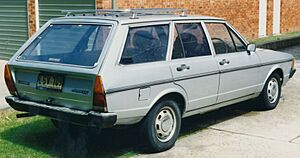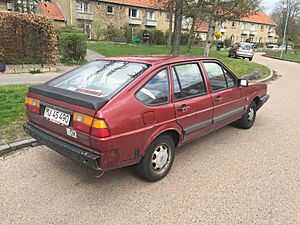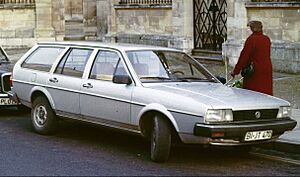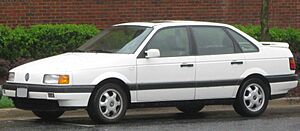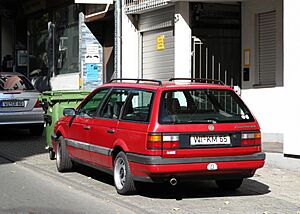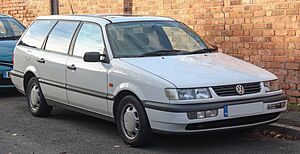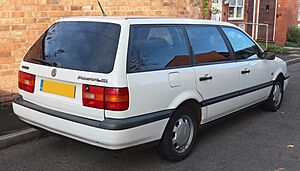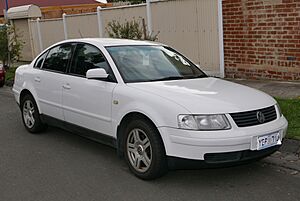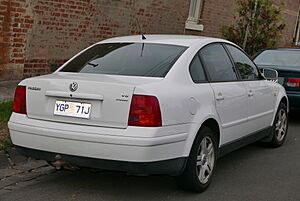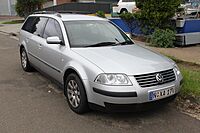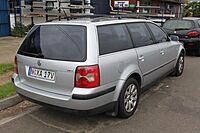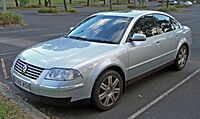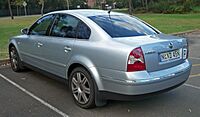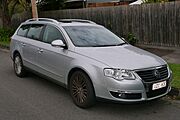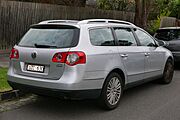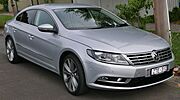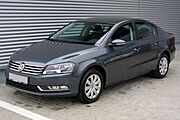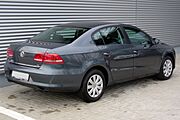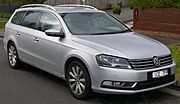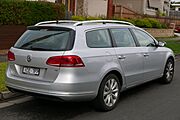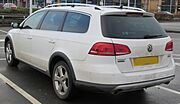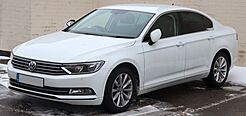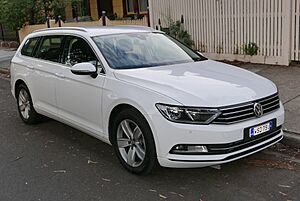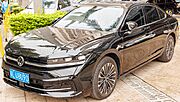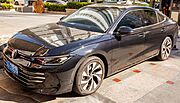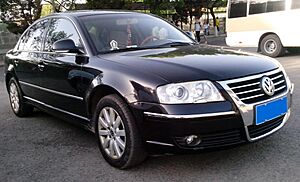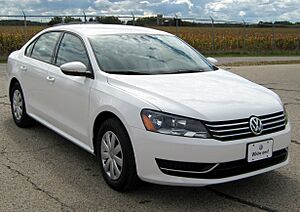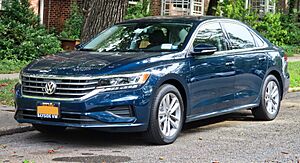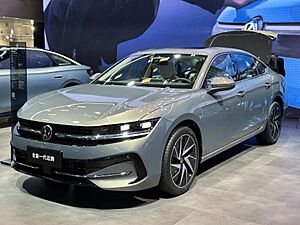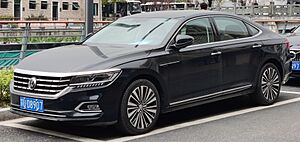Volkswagen Passat facts for kids
Quick facts for kids Volkswagen Passat |
|
|---|---|
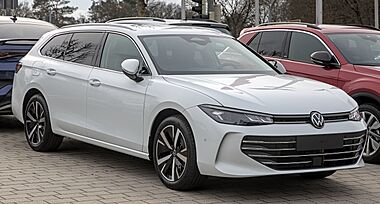
Passat B9
|
|
| Overview | |
| Manufacturer | Volkswagen |
| Also called |
|
| Production | 1973–present |
| Body and chassis | |
| Class | Mid-size car / large family car (D) |
| Layout | Front-engine, front-wheel-drive or four-wheel-drive |
| Chronology | |
| Predecessor |
|
| Successor | Volkswagen ID.7 (saloon) |
The Volkswagen Passat is a popular car model made by the German company Volkswagen. It has been produced since 1973. The Passat is known as a "large family car," which means it's a good size for families. It has also been sold under different names like Dasher, Santana, Quantum, Magotan, Corsar, and Carat. You can find the Passat as a sedan (a car with a separate trunk), a wagon (more space in the back), or a hatchback (a car with a back door that swings up).
In 2008, Volkswagen released a sportier version called the Passat CC in North America. It had a lower roof, making it look like a "four-door coupé". Later, its name changed to Volkswagen CC. The Arteon replaced the CC in 2017.
In January 2011, Volkswagen introduced a special Passat model line for North America and China. It was known as the New Midsize Sedan (NMS). This car was made in the US and China. It was designed to be bigger and more affordable to help Volkswagen sell more cars in these regions. This NMS Passat was sold in North America, South Korea, China, and the Middle East. Meanwhile, a different B8 Passat model, based on the MQB platform, started production in Europe in 2014.
By 2019, the Passat NMS program split. The North American version continued on an older platform. The Chinese Passat moved to the newer MQB platform. This meant Volkswagen was selling three different Passat models worldwide at that time! The North American Passat stopped being made after the 2022 model year.
Volkswagen stopped making the sedan version of the Passat for the European market in 2022. The B9 Passat, which came out in 2023, is only available as a wagon in Europe. However, the Passat is still sold as a sedan in China.
The name "Passat" is interesting! It's one of several Volkswagen models named after a wind. "Passat" is the German word for "Trade winds", which are strong, steady winds.
Contents
- First Generation: Passat B1 (1973)
- Second Generation: Passat B2 (1981)
- Third and Fourth Generations: Passat B3 and B4 (1988)
- Fifth Generation: Passat B5 (1996) and B5.5 (2001)
- Sixth and Seventh Generations: Passat B6 (2005) and B7 (2010)
- Eighth Generation: Passat B8 (2015)
- Ninth Generation: Passat B9 (2023)
- Other Passat Models Around the World
- Sales
- See also
First Generation: Passat B1 (1973)
The very first Volkswagen Passat arrived in 1973. It came in two-door and four-door sedan styles, and also as three-door and five-door versions. All these cars had a similar look, designed by a famous designer named Giorgetto Giugiaro. The first Passat was a "fastback" version of the mechanically similar Audi 80 sedan, which came out a year earlier. A five-door station wagon joined the lineup in 1974. In North America, this wagon was sold as an Audi Fox.
The Passat was a very modern family car for its time in Europe. It was meant to replace older Volkswagen models like the Type 3 and Type 4. It was one of the few cars of its size to have front-wheel drive and a hatchback.
The first Passat models used four-cylinder petrol engines, similar to those in the Audi 80. These engines were placed lengthwise in the car. Drivers could choose between a four-speed manual or a three-speed automatic gearbox.
In 1978, a diesel engine option became available. This was followed by a fuel-injected petrol engine in 1979, which offered more power.
The Passat received an updated look in 1977. This included changes to the inside and outside, like new indicator lights and different headlight options.
In North America, this car was called the Volkswagen Dasher. It launched in 1974 as a three-door hatchback, four-door sedan, and a station wagon. It first had a 1.5-litre engine. From 1976, it got a more powerful 1.6-litre engine with fuel injection.
The Dasher also got a facelift in 1978, similar to the European Passat. It featured new headlights and larger bumpers. In 1979, a 1.5-litre diesel engine was introduced, but it made the car quite slow.
In Brazil, the Passat B1 was made for a long time, from 1974 until 1988. It received some updates over the years, including bigger engines and a five-speed gearbox. A sporty version called the Passat TS 1.6 (and later Passat GTS 1.8 Pointer) was also available.
Second Generation: Passat B2 (1981)
The second generation Passat came out in November 1980. This car was also based on the corresponding version of the Audi 80, but it was a bit longer than the first Passat.
Besides the Passat hatchbacks and wagons, there was also a traditional sedan version. This sedan was sold as the Volkswagen Santana in Europe until 1985. In the United States, the Passat/Santana was called the Volkswagen Quantum. It was available as a three-door hatchback, four-door sedan, and a wagon.
A special four-wheel drive version, called the Syncro wagon, was introduced in 1984. It used a more powerful five-cylinder engine.
The Passat/Santana was also made and sold in many other countries. These included China, Mexico (where it was called VW Corsar), South America (VW Carat in Argentina, VW Quantum wagon in Brazil), and South Africa.
Most B2 Passats used four-cylinder petrol and diesel engines. The more powerful versions had five-cylinder Audi or VW engines. These ranged from 1.9 to 2.2 litres. The cars came with four-speed or five-speed manual gearboxes, or a three-speed automatic. Some models even had a special "Formel E" gearbox for better fuel economy. The four-wheel-drive system in the Syncro wagon was similar to the Audi 80's system.
In 1985, the Passat B2 received a small update. This included new, larger bumpers, changes to the interior, a new front grille, and new taillights on the hatchback. The three-door hatchback was no longer made. Also, the Santana name was no longer used in Europe.
Production of the B2 Passat in Germany ended in March 1988. Over 3.3 million cars were built there. Worldwide, about 4.5 million units were produced.
Third and Fourth Generations: Passat B3 and B4 (1988)
The third generation Passat, known as the B3, was launched in Europe in March 1988. It arrived in North America in 1990. This car had a unique front end without a traditional grille, which made it look very modern and aerodynamic. Its design was inspired by a concept car from 1981 called the Auto 2000.
This Passat was special because it was the first one built on a Volkswagen-designed platform, not one shared with an Audi sedan. It used a stretched version of the platform from the smaller Golf model. From this generation onwards, the Passat was sold only as a four-door sedan or a five-door wagon. It was called "Passat" in all markets, including North America, for the first time.
The engines in the B3 Passat used fuel injection, which gave them better performance. The engines were placed sideways in the car. Volkswagen's 'Syncro' four-wheel drive system was also available. Engine choices included a 2.0-litre 16-valve engine and a 1.8-litre engine. A powerful 2.8-litre VR6 engine was introduced in 1991, making the top-of-the-range Passat very fast. Diesel engines (1.9-litre and 1.6-litre) were also offered.
Passat B4: The 1993 Update
In 1993, the B3 Passat received a big update, so much so that it was called the B4. Even though it wasn't a completely new car, many parts of its exterior were changed, except for the roof and windows. The most noticeable change was the return of a front grille, which matched the look of other Volkswagen cars like the Mk3 Golf. The interior was also updated slightly, and important safety features like dual front airbags were added. The new grille gave the car a more "aggressive" look.
A new Turbocharged Direct Injection (TDI) diesel engine was available. This 1.9-litre turbodiesel engine was very fuel-efficient. For example, the sedan version could travel about 45 miles on one gallon of fuel on the highway in the US. With a large fuel tank, the B4 TDI wagon could travel over 1,800 kilometers (or 1,200 miles) on a single tank!
Fifth Generation: Passat B5 (1996) and B5.5 (2001)
A completely new Passat, the B5, was launched in Germany in 1996. It came to Europe and the UK in 1997, and to North America and Australia in 1998. This Passat shared its main structure with the first-generation "Typ 8D" Audi A4. This was a return to the Passat sharing its platform with an Audi model, something that hadn't happened since the second-generation Passat (B2) in 1981.
The B5 Passat introduced a fresh new design style for Volkswagen cars, which was also seen in models like the Mk4 Golf and Polo Mk4. Its sleek design helped it cut through the air very well, making it efficient.
The car had an advanced front suspension system. For models with front-wheel drive, it had a simpler rear suspension. However, 4motion four-wheel drive models had a more complex, fully independent rear suspension. The 4WD system was added in 1997 as an option for several engines. It helped the car maintain grip on the road. Several transmission options were available, including 5-speed and 6-speed manuals, and 4-speed and 5-speed automatics.
Passat B5.5: The 2001 Update
The B5.5 Passat began production in late 2000. This was an updated version of the B5, with changes to its look and some mechanical parts. These updates included new headlights, bumpers, taillights, and chrome details.
In 2001, a powerful 4.0-litre W8 engine was introduced in a luxury version of the car. This model came standard with 4motion all-wheel drive. This W8 engine was important because it was a test for Volkswagen Group's new "W engine" technology. This technology later appeared in even more powerful cars like the Phaeton and Bugatti Veyron. The W8 engine was no longer offered after 2004.
Sixth and Seventh Generations: Passat B6 (2005) and B7 (2010)
The B6 Passat was first shown at the Geneva Motor Show in March 2005. It launched in Europe in the summer of 2005. Unlike the previous Passat, the B6 no longer shared its main structure with the Audi A4. Instead, it was based on a changed version of the Mk5 Golf's platform. This meant the engine was placed sideways in the car, similar to the older B3 and B4 generations. This new platform made the car stronger and more rigid.
At the Frankfurt Motor Show in September 2007, Volkswagen introduced the 'R Line' R36. This sporty version had a powerful 3.6-litre VR6 engine.
Passat CC: A Stylish Version
The CC, which stands for "Comfort Coupé," is a 4-door coupé version of the Passat. It was first shown at the 2008 North American International Auto Show in Detroit. Originally aimed at competing with the similarly styled Mercedes CLS, the Passat CC was designed to be more stylish and luxurious than the regular Passat B6. In the US, the name Passat was dropped, and the car was sold as just CC.
Volkswagen updated the Passat CC in late 2011 for the 2012 model year. It received styling updates similar to the larger Phaeton. For this updated model, Volkswagen removed the Passat name in all markets, so it was known only as the Volkswagen CC.
Passat B7: The 2010 Update
The B6 Passat received an update, known as the B7, which was shown at the 2010 Paris Motor Show in September 2010. Even though it was called "B7" by fans, it wasn't a completely new car. The update brought new exterior panels, except for the roof and windows. The most noticeable changes were to the grille and headlights, along with small updates to the interior. The car's overall height and width stayed the same as the B6 Passat, but its length increased slightly.
Passat Alltrack: Ready for Adventure
In October 2010, Volkswagen showed the Passat Alltrack at the 2011 Tokyo Motor Show. The Passat Alltrack was designed to be a mix between a regular car and an SUV (Sport Utility Vehicle). It helped bridge the gap between Volkswagen's passenger cars and its SUVs like the Tiguan and Touareg. The Passat Alltrack was made to compete with cars like the Subaru Outback, which also offered a higher ride height and rugged body styling.
Eighth Generation: Passat B8 (2015)
The eighth generation of the Passat was revealed on July 3, 2014. Sales began in November 2014 in Europe and in January 2015 in the United Kingdom. It was available as a four-door sedan and a wagon. This Passat, like other new Volkswagen Group cars such as the Volkswagen Golf Mk7, was built on the MQB platform. This is a special building block system for cars with engines placed sideways at the front.
The Passat B8 continued to be sold in China under the name Magotan. This Chinese version had a wheelbase (the distance between the front and rear wheels) that was 80 mm longer, giving it more interior space.
Ninth Generation: Passat B9 (2023)
The ninth-generation Passat is mostly available as a wagon (called Variant) around the world. However, in China, it is also sold as a sedan. It was first shown on August 31, 2023, and officially debuted at the 2023 Munich Motor Show. This Passat is built on an updated version of the MQB Evo platform. It is assembled in Slovakia alongside the Škoda Superb, which it shares its base with.
The Magotan sedan, made by the FAW-Volkswagen company in China, was unveiled on April 25, 2024, at the 2024 Beijing Auto Show. It is also based on the same MQB Evo platform as the B9 Passat wagon sold globally.
The Passat Pro sedan, made by the SAIC Volkswagen company in China, is also based on the MQB Evo platform. It was released in September 2024. The Passat Pro has a different front look, similar to the Passat wagon, and is slightly shorter than the Magotan.
Other Passat Models Around the World
Passat Lingyu (China, 2005–2011)
The Passat Lingyu was a special version of the first-generation Škoda Superb made for the Chinese market. It was produced by SAIC Volkswagen starting in 2005, taking the place of the Passat B5. The car was designed by Murat Günak. In 2009, an updated version called the Passat New Lingyu was introduced. Production of this model continued until 2011, when it was replaced by the Passat NMS.
Volkswagen even built 20 special fuel-cell Passat Lingyu cars in mid-2008. These were shown at the 2008 Beijing Olympics.
Passat NMS (North America and China, 2011–present)
Starting in 2011, the Passat became two different models. One was sold in Europe and other right-hand drive markets, and in China as the Magotan. The other was the Passat NMS, made for North America and China. The NMS was designed to be a bit simpler and more affordable than the European Passat. This helped it compete better in the mainstream mid-size car market. In 2019, the Passat NMS model split again. The Chinese version moved to the newer MQB platform, while the North American model kept using its original platform.
Before it was officially shown in January 2011, this model was known as the New Midsize Sedan (NMS). It was created specifically for the North American market, replacing the B6 Passat sedan and wagon there. The Passat NMS was part of Volkswagen Group's plan to sell many more cars in North America. This car was sold in North America, South Korea, the Middle East, and China. The models for North America, the Middle East, and South Korea were made at Volkswagen's factory in Chattanooga.
In China, the new NMS model was built by SAIC-Volkswagen. It was sold as a more upscale car with some differences from the North American model. For example, it had a wood-trimmed steering wheel and rear air vents. It was sold alongside other models like the longer European Passat (Magotan) and the B5 Passat-based Passat Lingyu.
Passat NMS: North American Update (2019)
An updated Passat for the North American market was released in 2019 as a 2020 model. This 2020 Volkswagen Passat NMS had updated styling. It also included new standard safety and technology features. These included driver assistance systems and a modern touchscreen system for entertainment and information. This system also had 4G LTE internet connection for the car. The 2019 model kept its 174-horsepower, 2.0-litre petrol engine and six-speed automatic transmission. Volkswagen stopped making the Passat in North America after the 2022 model year because sales were slow.
Magotan (China, 2005–present)
In China, the European version of the Passat is sold as the VW Magotan. This started with the B6 generation and is produced by FAW-Volkswagen. The newest Magotan model, sold since 2024, is based on the B9 version of the European Passat.
Passat (China, 2011–present)
The Passat name was first used in China in 2011, when SAIC Volkswagen started selling the North American Passat NMS.
In October 2018, the 2019 Passat for the Chinese market was shown. This car used the same Volkswagen Group MQB platform as the European Passat and VW Magotan, but it was not directly based on them. This means that even though the Chinese and North American Passats looked very similar, they now used different platforms. The Volkswagen Magotan (China) and Volkswagen Passat NMS (China) are very similar cars. They both use the MQB platform and have the same wheelbase, but they have slightly different sizes and looks. The latest generation, based on the B9 version of the European Passat, launched in 2024.
Different versions of the car are called 280TSI, 330TSI, and 380TSI. The 280TSI models have a 1.4-litre engine. The 330TSI and 380TSI models have a 2.0-litre engine. All models come with a 7-speed automatic gearbox as standard.
Sales
| Year | Europe | U.S. | China | |
|---|---|---|---|---|
| Passat | Magotan | |||
| 1990 | 17,945 | |||
| 1991 | 15,833 | |||
| 1992 | 12,578 | |||
| 1993 | 11,970 | |||
| 1994 | 11,021 | |||
| 1995 | 14,010 | |||
| 1996 | 19,850 | |||
| 1997 | 275,872 | |||
| 1998 | 348,398 | 39,272 | ||
| 1999 | 323,415 | 68,151 | ||
| 2000 | 260,112 | 84,521 | 30,081 | |
| 2001 | 332,466 | 95,028 | 64,593 | |
| 2002 | 286,075 | 96,142 | 70,091 | |
| 2003 | 259,362 | 76,977 | 122,445 | |
| 2004 | 227,524 | 67,640 | 74,877 | |
| 2005 | 272,762 | 49,233 | 70,501 | |
| 2006 | 331,917 | 54,208 | 114,018 | |
| 2007 | 301,645 | 37,183 | 164,368 | 26,690 |
| 2008 | 236,193 | 30,034 | 100,902 | 52,506 |
| 2009 | 177,450 | 11,138 | 113,275 | 67,018 |
| 2010 | 158,269 | 12,497 | 130,971 | 78,859 |
| 2011 | 235,143 | 22,835 | 165,858 | 89,839 |
| 2012 | 194,738 | 117,023 | 233,321 | 173,667 |
| 2013 | 156,025 | 109,652 | 227,262 | 187,173 |
| 2014 | 153,677 | 96,649 | 218,344 | 207,243 |
| 2015 | 226,127 | 78,207 | 205,794 | 155,507 |
| 2016 | 206,813 | 73,002 | 188,214 | 171,283 |
| 2017 | 183,288 | 60,722 | 160,324 | 216,303 |
| 2018 | 154,074 | 41,401 | 179,028 | 228,990 |
| 2019 | 124,650 | 14,123 | 214,061 | 169,242 |
| 2020 | 115,363 | 22,964 | 145,805 | 170,330 |
| 2021 | 82,488 | 24,396 | 124,402 | 147,340 |
| 2022 | 65,844 | 2,408 | ||
See also
 In Spanish: Volkswagen Passat para niños
In Spanish: Volkswagen Passat para niños


